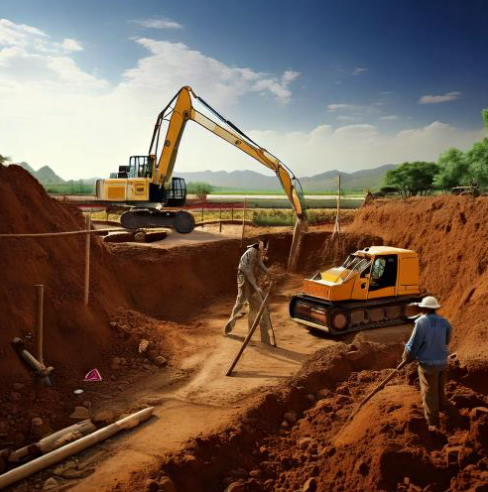What is Trenching?
Definition
Trenching involves excavating narrow, elongated channels in the ground to install or repair underground utilities such as water pipes, gas lines, electrical cables, and telecommunications conduits.
Types of Trenching
- Open-Cut Trenching:
- Involves digging a fully exposed trench from the surface to the installation depth.
- Commonly used for new installations or major repairs.
- Micro-Trenching:
- A minimally invasive method creating smaller, shallower trenches.
- Ideal for fiber-optic cable installation.
Equipment Used in Trenching
- Excavators: For large-scale trenching projects.
- Trenchers: Machines specialized in cutting trenches efficiently.
- Shovels and Hand Tools: For smaller or more precise trenching tasks.
Applications of Trenching
- Installing water and sewage pipelines.
- Laying electrical and telecommunication cables.
- Repairing damaged underground utilities.
Advantages of Trenching
- Cost-Effective: Straightforward and suitable for projects with open access.
- Versatile: Applicable to a wide range of terrains and utility types.
- Accessible: Allows direct access to utilities for repairs or inspections.
Challenges of Trenching
- Disruption to the surface, such as roads or landscapes.
- Longer project times for deep or extensive trenches.
- Higher risk of accidents, such as cave-ins, if safety measures are not followed.
What is Directional Drilling?
Definition
Directional drilling, also known as horizontal directional drilling (HDD), is a trenchless technology used to install underground utilities by drilling a controlled pathway below the surface.
Process of Directional Drilling
- Pilot Hole Drilling: A small, guided drill bit is used to create the initial pathway.
- Pathway Enlargement: The pilot hole is widened using reamers to accommodate the utility being installed.
- Utility Installation: Pipes, cables, or conduits are pulled through the drilled pathway.
Equipment Used in Directional Drilling
- Drill Rigs: Machines that drive the drilling process.
- Drill Bits: Designed for specific soil types, such as rock, clay, or sand.
- Tracking Systems: Used to monitor and guide the drill’s path accurately.
Applications of Directional Drilling
- Installing utilities under roads, rivers, or other obstacles.
- Laying pipelines for water, gas, or oil without disrupting the surface.
- Expanding telecommunication networks in urban areas.
Advantages of Directional Drilling
- Minimal Surface Disruption: Ideal for urban environments or environmentally sensitive areas.
- Faster Installation: Reduces the time needed compared to traditional trenching.
- Versatility: Can navigate around obstacles and handle varying soil conditions.
Challenges of Directional Drilling
- Higher initial costs due to specialized equipment and expertise.
- Limited application for shallow installations or small-scale projects.
- Requires precise planning to avoid existing underground utilities.
Comparison: Trenching vs. Directional Drilling
| Aspect | Trenching | Directional Drilling |
|---|---|---|
| Surface Disruption | Significant surface disruption. | Minimal, suitable for urban areas. |
| Cost | Generally lower cost for shallow installations. | Higher upfront costs but efficient for obstacles. |
| Speed | Slower due to excavation and restoration work. | Faster, especially for complex pathways. |
| Versatility | Limited to straightforward pathways. | Can navigate around obstacles and varying depths. |
| Environmental Impact | More intrusive to the environment. | Eco-friendly with reduced surface disruption. |
How Trenching and Directional Drilling Complement Each Other
While trenching and directional drilling are distinct methods, they are often used together for comprehensive utility installation projects:
- Primary Installation: Directional drilling can handle challenging sections, such as under roads or waterways, while trenching is used for open areas.
- Cost Management: Trenching is applied where feasible to reduce costs, and drilling is reserved for areas requiring precision or minimal impact.
- Safety and Efficiency: Combining methods ensures that projects adhere to safety standards while meeting deadlines.
Safety Considerations
Both trenching and directional drilling come with unique safety requirements:
- Trenching Safety:
- Use trench boxes or shoring to prevent collapses.
- Monitor soil stability and weather conditions.
- Train workers in excavation safety protocols.
- Directional Drilling Safety:
- Conduct utility locates using Ground Penetrating Radar (GPR) or similar technologies.
- Ensure proper drill calibration to prevent accidents.
- Maintain clear communication between drill operators and support teams.
The Future of Utility Installation
Innovations in trenching and directional drilling are driving the future of infrastructure development:
- Automation and Robotics: Advancements in machine technology improve precision and reduce labor demands.
- Eco-Friendly Solutions: Methods that minimize environmental impact, such as HDD, are gaining popularity.
- Smart Utility Mapping: Integration of digital mapping tools ensures safer and more efficient utility installations.
Frequently Asked Questions (FAQs)
1. When should I choose trenching over directional drilling?
Trenching is ideal for open areas with no surface restrictions or shallow installations. These guys at triplejconstructionandutilitiesllc.com/ can give you good advice on that.
2. Is directional drilling more expensive than trenching?
While drilling has higher upfront costs, it can save money in projects requiring minimal surface disruption or navigating obstacles.
3. Can trenching and directional drilling be used together?
Yes, combining both methods often yields the best results for complex utility installation projects.
4. What equipment is essential for trenching?
Trenchers, excavators, and hand tools are commonly used in trenching projects.
5. How does directional drilling navigate obstacles?
Using advanced tracking systems and flexible drill bits, directional drilling can curve around obstacles or follow precise paths.
6. Is directional drilling environmentally friendly?
Yes, it minimizes surface disruption and reduces the environmental impact compared to open-cut trenching.
Conclusion
Trenching and directional drilling are indispensable techniques in modern utility construction, each offering unique advantages. Trenching provides a straightforward solution for open areas, while directional drilling excels in navigating challenging environments with minimal disruption. By understanding these methods and their applications, construction projects can achieve optimal efficiency, safety, and sustainability. Whether installing pipelines, cables, or conduits, these techniques ensure the foundation of modern infrastructure is built to last.
